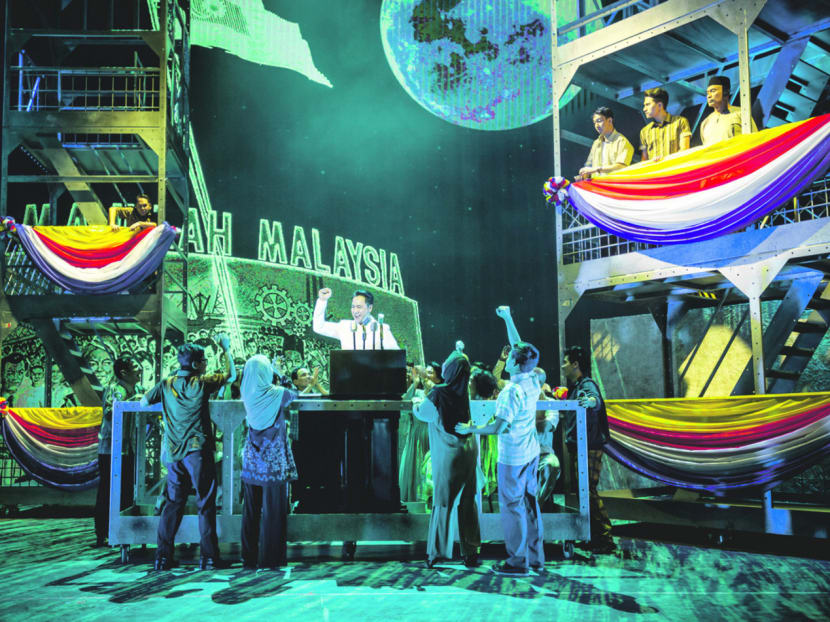Theatre review: Singapura The Musical
SINGAPORE — Creator and composer Ed Gatchalian’s Singapura: The Musical is two and half hours of one seemingly unrelated story tacked on to another, and — to be absolutely frank — about two hours too long. The audience is presented with a multiracial love triangle between a young Chinese girl, a British officer and a (unfortunately “friendzoned”) young Malay boy. It was an unconvincing love story tied in with an “ordinary” family’s anguish, fears and woes as they live (and die) through the turbulence of 1950s and 60s Singapore. This is further shoehorned into the larger “Singapore Story” of how this country went from Third World to First in just a space of 50 short years.

Singapura rings hollow despite impressive staging. Photo: Singapura: The Musical.
SINGAPORE — Creator and composer Ed Gatchalian’s Singapura: The Musical is two and half hours of one seemingly unrelated story tacked on to another, and — to be absolutely frank — about two hours too long. The audience is presented with a multiracial love triangle between a young Chinese girl, a British officer and a (unfortunately “friendzoned”) young Malay boy. It was an unconvincing love story tied in with an “ordinary” family’s anguish, fears and woes as they live (and die) through the turbulence of 1950s and 60s Singapore. This is further shoehorned into the larger “Singapore Story” of how this country went from Third World to First in just a space of 50 short years.
If all this seems like a lot of ground to cover in a single musical: It is. And if the question is whether Gatchalian succeeds in covering that ground in a convincing manner: The answer is, no.
It is hard to pin down exactly what makes Singapura: The Musical so difficult to connect with. For one, Gatchalian unabashedly credits the first volume of the late Mr Lee Kuan Yew’s memoirs as the initial inspiration. The result is an overarching narrative that would not have felt out of place being taught in a school social studies lesson. There are no awkward questions asked; no new insights provided. The portrayal of events such as the Hock Lee bus riots, merger with Malaysia, Konfrontasi and the 1964 racial riots through the eyes of ordinary Singaporeans may be novel but shallow even though Gatchalian claimed to have spoken to people who had lived through those turbulent years to hear their personal stories.
Singapura: The Musical is based on real events, but never at any point feels real. Apart from the late Mr Lee (ironically never named, but referred to simply as the “Man in White”), heavyweights from Singapore’s past, such as opposition figures Lim Chin Siong and Syed Jaafar Albar, are whitewashed from the narrative entirely. And other than a single touching moment during the “Trouble (Hock Lee)” number, where the names and stories of those who lost their lives during the Hock Lee bus riots were acknowledged on stage, the musical dispenses dealing with real people, real deaths and real disagreements, preferring instead to peddle a romantic (and fantastic) view of the past as one where Chinese, Malays and Indians come together to dance at the Kopitiam and where 16 September 1965 is heralded by a sign reading “Merdeka!” floating across the stage held up by red helium balloons.
Audiences are also likely to have difficulties seeing our multiracial Singapore society in the almost entirely non-Singaporean cast. Colour-blind casting, while laudable in most other situations, strikes a discordant note in a production that purports to take us through very specific Chinese-Malay racial tensions. Just hearing the inconsistent accents from a cast that clearly had to be taught how to use “lah” and to say “kopitiam” and “gilat” only serve to remind one of how much local musical talent (both Chinese and Malay) were left out here. Could none of them have been cast in lead or supporting roles?
The production is not without any redeeming features. Director Greg Ganakas creates some impressive visual tableaux through deploying his large cast effectively against an audio-visual backdrop and creating enough action and dynamism to fill the Capitol Theatre’s impressive new Rococo-style space. Gregory Gale’s modular and multi-level set design is also impressive, if a little inefficient. On the whole, though, both the quality of acting and singing in this supposedly Broadway/West End-ready cast was patchy. During the show, I was also plagued by a chorus of “Whys” in my head. Just take the scene of the random woman walking across the stage dressed as empress dowager? What has such a woman to do with the transition in time and space from modern-day Singapore to the days when our ancestors arrived on this island seeking a new life?
Ultimately, Singapura: The Musical is not a production that strikes a familiar chord. The non-Singaporean origin of the entire project aside, it rings especially hollow as we’ve reached a state where we’re interested in and hungry for works of art that will portray our history in all its naked truth. After 50 years, we are (and should be) rapidly approaching a point when we are prepared to examine our past with an objective and critical eye. We deserve works that are willing to confront our history with bravery and with honesty. Singapura: The Musical fails to deliver on that score. Karin Lai
Singapura: The Musical runs until June 7 at Capitol Theatre. Tickets from S$65 at http://www.singapurathemusical.com





